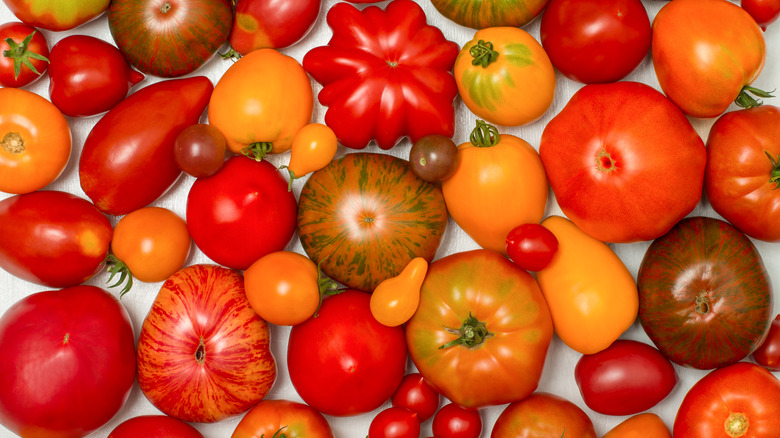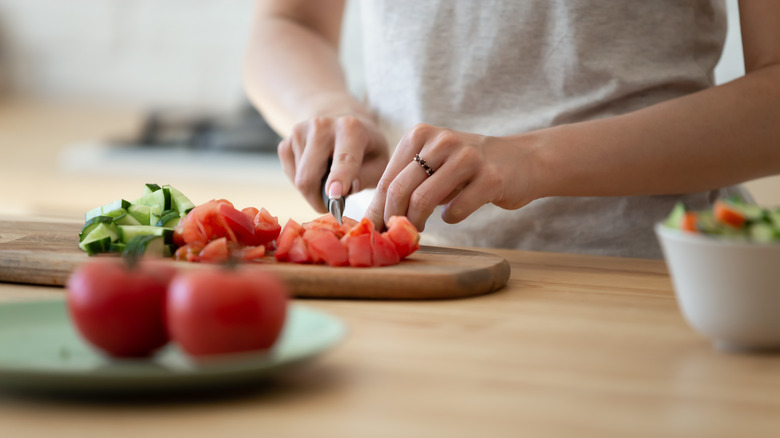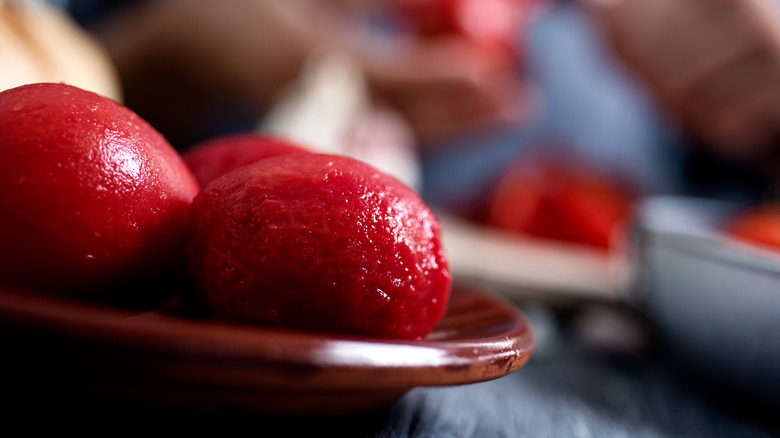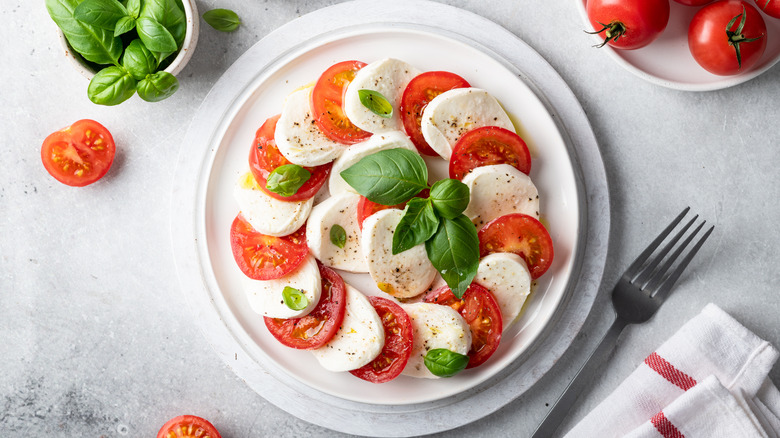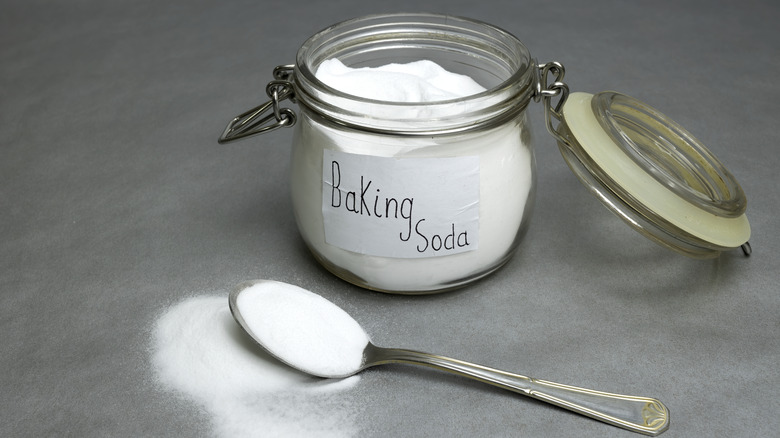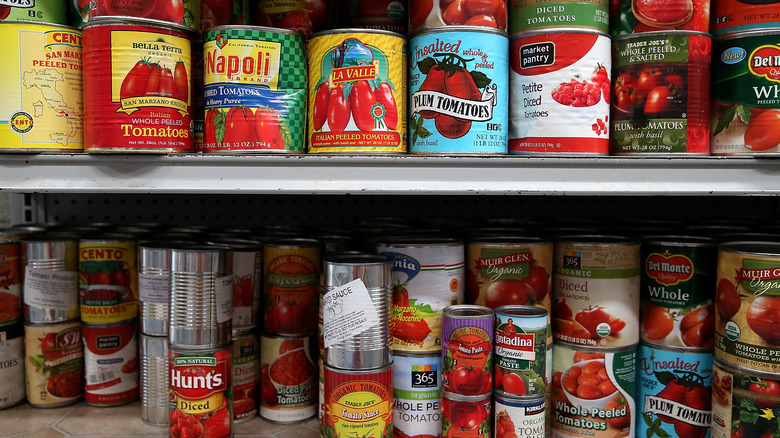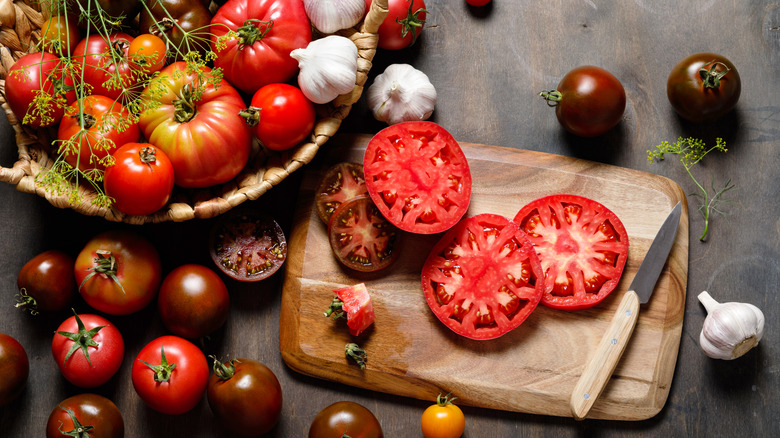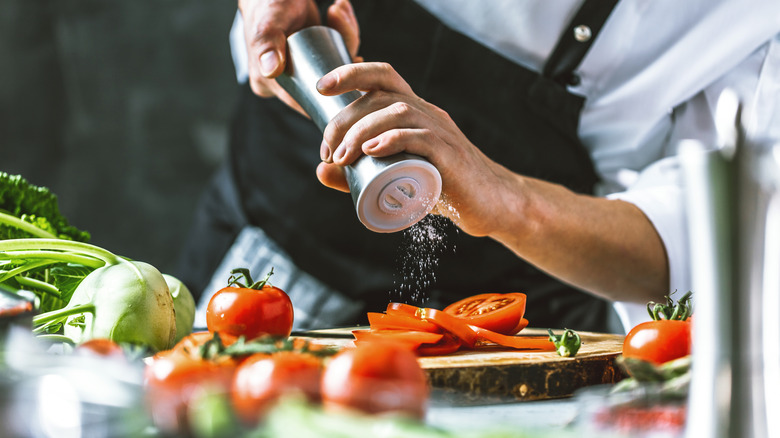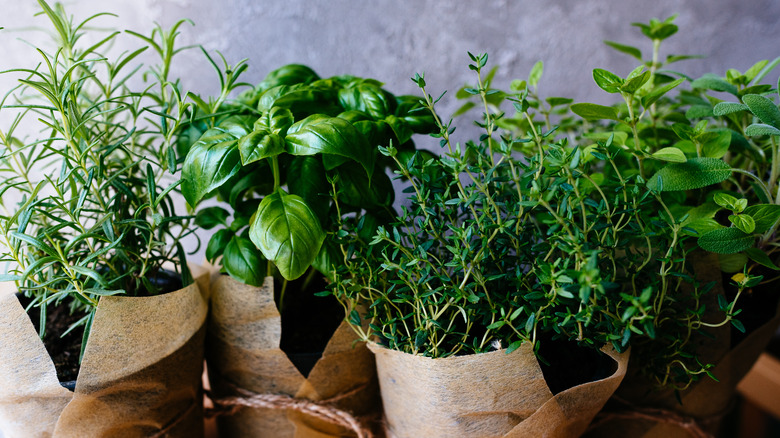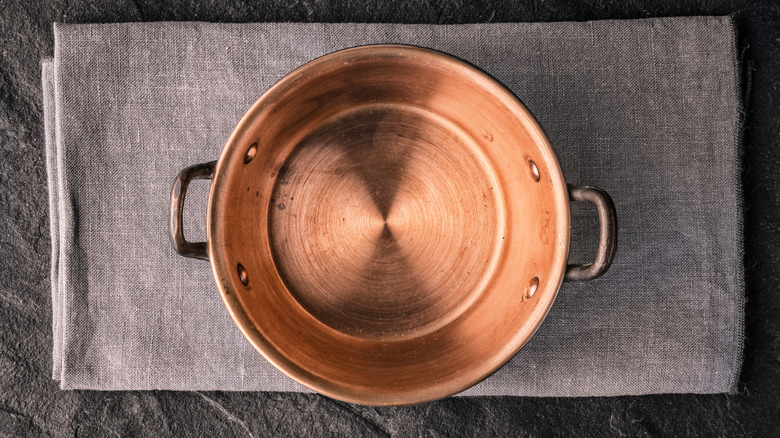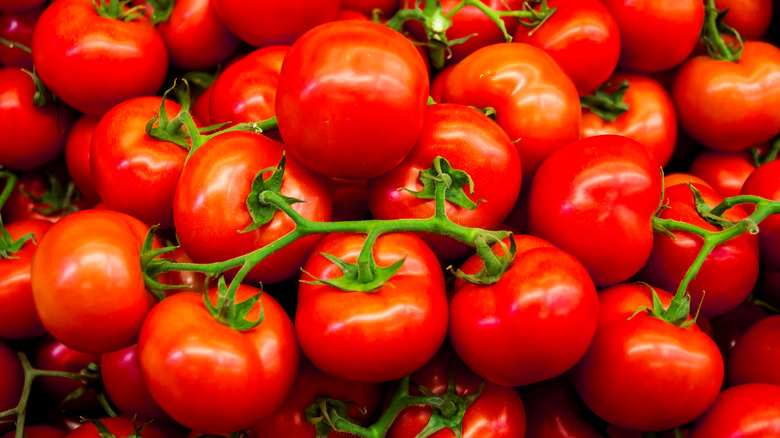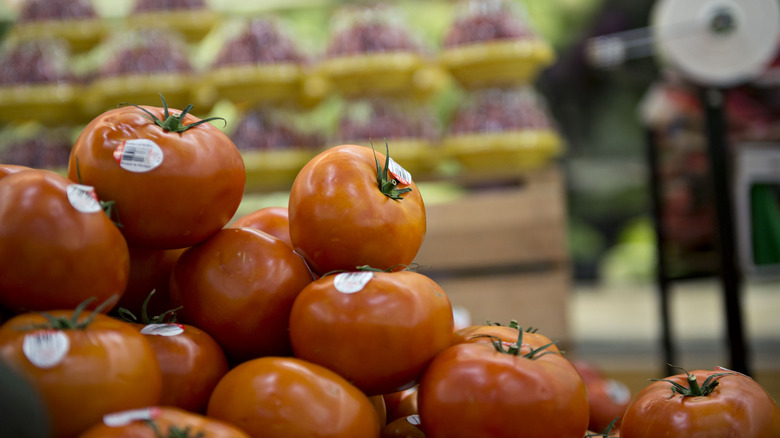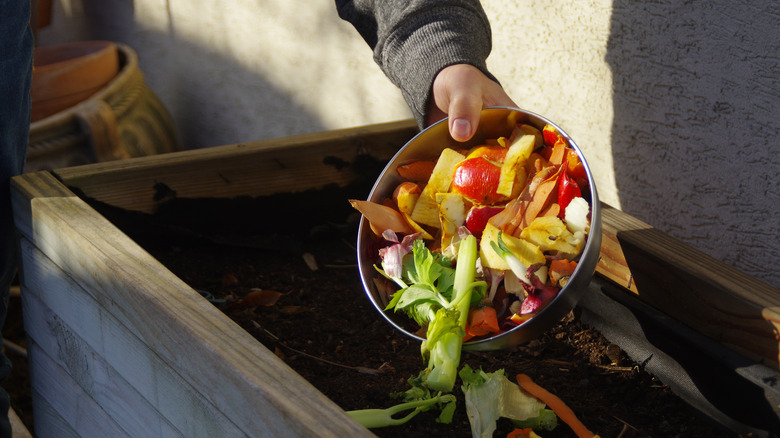12 Mistakes Everyone Makes When Cooking Tomatoes
Of all the ingredients you use in your kitchen, it may seem like tomatoes are one of the most straightforward. But even those who enjoy rainbow-hued salads on the regular may be making some mistakes when it comes to choosing, preparing, and cooking their tomatoes. Like any other ingredient, knowing more about what to do — and what not to do — can make a huge difference in dishes that utilize it. And since the humble tomato is so often misunderstood, it's especially important to pay attention if you want tasty results.
There's a good chance you've made some common tomato prep and cooking mistakes yourself. By learning what not to do, you can ensure you're always preparing your tomatoes to the best of your ability. We've collected the top tomato faux pas people make when cooking with the juicy plump fruit. Avoid these and your salads, sauces, and sandwiches are going to be that much better.
1. Using the wrong knife
Perhaps the biggest tomato struggle comes down to what kind of knife you're using. We all know how big of a mistake it is to use the wrong knife — it can make an absolute mess and pretty much destroy your tomato in the process. While you may think that a sharp paring knife (like the kind you'd use for other veggies) would easily cut through a tomato, you're wrong. According to Allrecipes, this type of knife is unlikely to be sharp enough to complete the task at hand.
Rather, you're going to be better off using a serrated knife that has little teeth along the blade. You'll be able to slice open the tomato skin with a simple back and forth sawing motion. It also avoids the messy fate of squishing out all of the seeds and juices without actually cutting through the flesh.
A bread knife may not be ideal for this task — you want it to be a bit finer than that — but it's possible to make it work if that's all you have. Investing in a small serrated knife is your best bet in this case. For anyone who loves eating tomatoes on the regular, it's definitely worth it.
2. Forgetting to peel your tomatoes
Ah, the age-old question: Should you be peeling your tomatoes? In some cases, Epicurious tells us that peeling just isn't necessary. For example, if you're going to be eating your tomatoes fresh, there's no compelling reason to peel them. It'll just be messy and give you way more work than you probably want to put into the process. However, when it comes to some recipes, peeling the skin off beforehand is of utmost importance.
Why? It's mostly a texture thing. If you're cooking your tomatoes or adding them to a puree or sauce, you're going to notice that the skins don't break down as easily as the rest of the fruit. Additionally, tomato skins contain compounds that can make them taste bitter, which probably isn't what you're aiming for when you're making a marinara.
Of course, the police aren't going to show up at your kitchen if you decide not to peel your tomatoes: It's not really that big of a deal. However, most people prefer their sauces and purees to be skin-free, so keep this in mind when you're taking on your next tomato-based cooking project.
3. Deciding to cook them at all
So, you have a ton of fresh tomatoes in your house, and you don't know what to do with them. It's not an uncommon problem, especially if you love spending time in the produce aisle or have an abundant garden. But just because you're trying to use up your store of tomatoes doesn't mean you have to cook them all immediately. Although it is true that many of the healthy nutrients in tomatoes become more potent when they're cooked, per Livestrong, eating raw tomatoes is also a great way to add plenty of nutrients, like vitamins A, K, and B6 to your diet.
Plus, if you're using good-quality tomatoes, you'll quickly realize that eating them raw will help you enjoy the flavor even more. They're amazing in salads or even just on their own with some salt and pepper sprinkled on top. During the summer months when tomatoes are at their ripest, eating raw tomatoes is the best way to enjoy the season.
4. Not adding baking soda to your tomato sauce
Sometimes, when you want tomato sauce for a dish, you just buy the canned or jarred stuff and call it a day. But when you have fresh tomatoes and a little extra time on hand, you may want to try making your tomato sauce from scratch. In theory, this should be super easy: Just cook the tomatoes down, and they'll be good to go, right? But it's not always that simple.
One issue that home cooks often run into is acidic-tasting tomato sauce. This is more likely to be a problem if you're using tomatoes that aren't quite ripe enough. According to The Spruce Eats, adding some baking soda to your sauce is a great way to reduce the acidity and make your sauce more pleasant. The outlet recommends using a quarter teaspoon per gallon of sauce to fix the issue. If you generally add sugar to your tomato sauce, it also helps make the acidity even less perceptible.
This amount of baking soda seems so small that you might think you wouldn't even notice the difference. But just a sprinkle of the stuff can go a long way. This is a trick that you probably wouldn't think of yourself, but once you give it a try, you'll realize it works.
5. Using fresh tomatoes instead of canned
Unfortunately, many people have a bias against canned food. They associate it with bland, mushy vegetables and unpleasant textures and flavors that can never compare to the fresh version. Look, we get it to some extent: Canned green beans are never going to be as good as fresh ones. But in some cases, canned foods can actually be way easier — not to mention more delicious — than the fresh stuff. And tomatoes definitely fall into that category.
The Daily Meal explains that a lot of it comes down to seasonality. In the warmest days of summer, it probably won't be too difficult to find amazing, fresh tomatoes that you just can't wait to cut open. But in the depths of winter in the Northeast, you're not going to have the same kind of luck. During those months, canned tomatoes are likely to be fresher.
Additionally, canned tomatoes can be a lot easier to work with. Consider whether you would want to make your own tomato paste yourself or just scoop it out of a can. Not to mention, canned tomatoes often have a stronger concentrated flavor, which is certainly a plus in many dishes. So, you shouldn't ditch fresh tomatoes altogether, but don't forget about everything that high-quality canned tomatoes have to offer.
6. Neglecting to remove the seeds
If you're anything like us, tomato seeds can throw off your cooking process. And if you don't handle them properly, they can make a big mess in your kitchen too! Thankfully, depending on the recipe, you don't have to worry about removing the seeds at all. For example, if you're cooking your tomatoes down or making a puree or sauce, then you can just leave them whole and get cooking.
However, in many other preparations, PureWow suggests removing tomato seeds. According to the site (and our personal experience), keeping those seeds — and the gunk that surrounds them — in your finished dish results in an "extra gooey and watery" consistency. And yes, that's just as unappealing as it sounds. Generally, it's as easy as scooping the seeds out of the tomato after you've cut it. That way, you don't have to worry about the extra moisture wilting your greens or subjecting you to a glob of tomato juice when you're trying to enjoy your salad.
7. Not salting your tomatoes
Perhaps one of the most important steps in prepping your tomatoes comes down to a single ingredient: salt. It's one of the simplest items in your kitchen, but it enhances flavors so that everything tastes delicious — in moderation of course! And while it's an important element in most dishes, tomatoes are one place where you really, really don't want to forget it.
That's because, according to Serious Eats, adding salt to tomatoes starts the process of osmosis, which basically just means that the salt draws liquid out from the tomatoes. The resulting tomato is far less watery, and its flavors become more concentrated. Not only are you getting that additional taste from the salt itself, but your tomato will actually taste more, well, tomato-y. Salt also reduces bitterness in food, which will in turn make your tomatoes taste sweeter. And that's not all! Since salt makes you salivate, it also means that those flavors are more widely distributed in your mouth.
But you don't really need to know all the science behind it. Just remember: Salting your tomatoes is almost always a good idea.
8. Not pairing your tomatoes with the best herbs
Tomatoes are delicious on their own, and you can eat them solo and still be satisfied with the result. However, it's fair to want to get as much out of your produce as possible, and for most people that means seasoning their food well. We've already discussed the importance of salting your tomatoes, but that doesn't mean you should stop there. Rather, plenty of amazing herbs can take whatever tomato dish you're making to the next level.
A lot of these pairings are classic: For example, oregano and basil infuse a lovely burst of flavor to fresh or cooked tomatoes. Plenty of other herbs like dill, thyme, tarragon, parsley, and chives can liven your tomatoes up and make them into something special. Meanwhile, black or white pepper can introduce some earthiness to the fruit. It only takes a few extra minutes to chop up some herbs (or sprinkle on the dried variety), so you definitely shouldn't skip this step if you're trying to make your tomatoes as flavorful as possible.
9. Cooking your tomatoes in reactive cookware
Getting ready to cook your tomatoes? Whatever you're making is surely going to taste great. However, before you start heating your pan over the stove, let's make sure you're using the right kind. Tomatoes and other acidic foods don't work well with certain materials. Reactive cookware, per The Spruce Eats, releases metallic atoms as it heats your food, and acidic ingredients hold onto those atoms really well. In turn, it can lead to discoloration or even a change in flavor — probably not what you're looking for in your next tomato-based dish. Reactive metals include copper, aluminum, and non-stainless steel.
You're best off using non-reactive cookware made from materials like glazed ceramic and glass. Additionally, enamel-coated pans deliver the same benefits. Before you get cooking, make sure you have the right types of pans to get the job done well. Your tomatoes — and your tastebuds — will thank you for it.
10. Not choosing the right tomatoes
We know that cooking tomatoes correctly is of utmost importance if you want to achieve the best possible tomato-based dish. But perhaps even more essential is the step that comes before you start cooking at all: choosing your tomatoes. You'll want to make sure that you're getting the best possible quality since subpar tomatoes can be really disappointing.
According to The Kitchn, your best bet is using locally grown tomatoes. If you're buying them from a region far away, they were probably picked when they were still green and only ripened off the vine. This is going to lead to a less flavorful, overall less enjoyable tomato, which is best to avoid if possible. It's also important to pay attention to how the tomato feels. Pick fruit that is heavy in your hand and has a little give when you press into it. If the skin feels too loose or flabby, there's a good chance it has ripened past its prime. Slightly overripe tomatoes can be okay if you're cooking them, but they're not great for eating fresh.
11. Only buying your produce from the grocery store
Have you noticed that whenever you buy a tomato from the grocery store it just doesn't taste that good, but when you enjoy a tomato fresh from a garden it seems like the best thing you've ever eaten? Well, there's a reason for that and it largely comes down to capitalism. According to Live Science, most commercial tomato varieties are not chosen for their flavor but rather for high yields: After all, the more tomatoes a producer can grow, the more money they can make. It might be good for the farmer's bottom line, but it certainly isn't great for taste-oriented consumers.
Therefore, you might want to branch out and try getting your tomatoes elsewhere instead of just picking them up at the grocery store. Buying fresh produce from a farmer's market is always a smart idea — just make sure that the tomatoes you're getting are actually grown locally. And if you want to be even closer to the source, consider growing your own tomatoes if you have the space. It's a fun project, and you'll be rewarded with an incredible summer bounty.
12. Forgetting to compost scraps
Food waste is a huge problem in the U.S. According to the USDA, 30% to 40% of the food produced in the United States ends up in a landfill. Yes, this includes the bag of kale in the back of your fridge you always knew you weren't going to finish, but it also includes all the parts of our food we don't eat. Just think about it: When you slice into a tomato and clean out its seeds, you're actually trashing a significant portion of the fruit. Of course, go ahead and save these scraps if you can. Storing them in a zip-top bag in the freezer is a good idea if you want to make homemade veggie broth later.
But if you know you're not actually going to use your scraps and you're used to just pitching them in the trash, you might want to try composting instead. You can easily compost in your own home as long as you have a separate bin, and then you can use that compost in your own yard. Plus, some cities have composting services to remove the waste from your home when the bin is all filled up.
